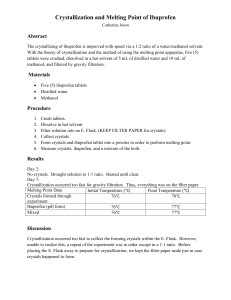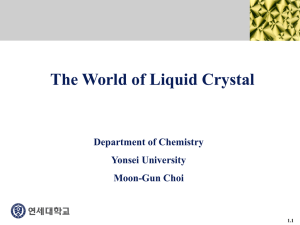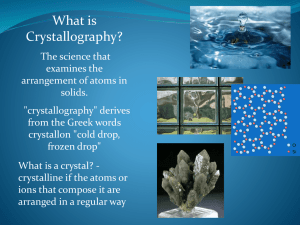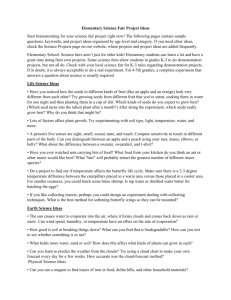Y2 GPP new
advertisement
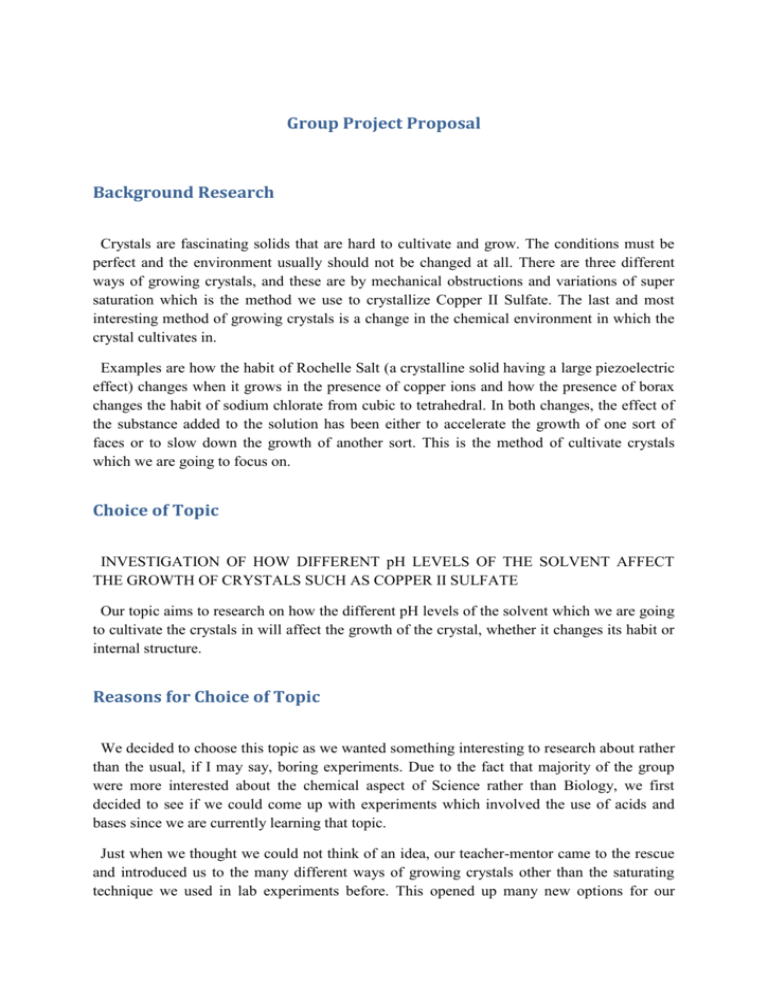
Group Project Proposal Background Research Crystals are fascinating solids that are hard to cultivate and grow. The conditions must be perfect and the environment usually should not be changed at all. There are three different ways of growing crystals, and these are by mechanical obstructions and variations of super saturation which is the method we use to crystallize Copper II Sulfate. The last and most interesting method of growing crystals is a change in the chemical environment in which the crystal cultivates in. Examples are how the habit of Rochelle Salt (a crystalline solid having a large piezoelectric effect) changes when it grows in the presence of copper ions and how the presence of borax changes the habit of sodium chlorate from cubic to tetrahedral. In both changes, the effect of the substance added to the solution has been either to accelerate the growth of one sort of faces or to slow down the growth of another sort. This is the method of cultivate crystals which we are going to focus on. Choice of Topic INVESTIGATION OF HOW DIFFERENT pH LEVELS OF THE SOLVENT AFFECT THE GROWTH OF CRYSTALS SUCH AS COPPER II SULFATE Our topic aims to research on how the different pH levels of the solvent which we are going to cultivate the crystals in will affect the growth of the crystal, whether it changes its habit or internal structure. Reasons for Choice of Topic We decided to choose this topic as we wanted something interesting to research about rather than the usual, if I may say, boring experiments. Due to the fact that majority of the group were more interested about the chemical aspect of Science rather than Biology, we first decided to see if we could come up with experiments which involved the use of acids and bases since we are currently learning that topic. Just when we thought we could not think of an idea, our teacher-mentor came to the rescue and introduced us to the many different ways of growing crystals other than the saturating technique we used in lab experiments before. This opened up many new options for our group to think about. Before long, we came up with this idea about changing the environment of the solvent in which the crystal is growing through various pH levels. Through this research, we can hopefully find the optimal pH level to grow crystals in whether it is to accelerate the growth or change the shape of the crystal. Even though it is on a small-scale level, our results could potentially affect the way crystals are grown in the future. For example, if we find out that Copper II Sulfate crystallizes best at pH 2, then in the future for science experiments we could make the solvent pH level 2 in order to produce the best quality crystals. Feasibility of the project We feel that it is possible to carry out our research. There are many books and articles online on how to grow crystals by altering the chemical environment which we can refer to. There are also many experience and veteran science teachers in our school that can greatly aid our research and provide us with valuable information. Furthermore, we also have done some past crystallization experiments so we know roughly what to expect, although some features of the crystals could alter due to being in the presence of the acidic or alkaline solvent. Most of the chemicals and apparatus can also be obtained from the school lab scientists and this will greatly facilitate our research and make it convenient for us to conduct the crystallization process. However, due to the fact that most crystals take a few months to completely crystallize, we will have to select chemicals that can crystallize within a month or so such as Copper II Sulfate. As long as we can find suitable chemicals, everything should be feasible to conduct. Manageability of project The project will be carried out over a span of 2 months, from February to April 2012. Throughout the course of the project, many tasks will have to be completed in order to meet the tight datelines. Hence, there will be a constant need for teamwork within the group. For example, when carrying out the crystal-growing investigation, group members will have to perform separate duties such as taking down results or conducting the experiment. From this, it can be seen that there will be multiple opportunities for group work during the project. Accessibility of the information required The information we would need is the variables in the crystals which we intend carry out an experiment to obtain it. We could refer to scholarly journals from which they tested about using different solvents to form crystals. This might come in use to further understand the results. Some problems we would anticipate in getting our materials are that it would be slightly costly and that it might be hard to find. We can also interview science chemistry teachers if we have the spare time in order to find out more about crystallization and how the experiment should be set up. Methods used to carry out the project We plan on gathering the required information by conducting experiments, as this is meant to be a Science Investigative Project. Surveys and interviews are unnecessary as the information needed for a conclusion can come straight from an experiment. Besides the above, we may be able to supplement the results we get with reports published by others as we may only be able to find out what happens, and not the underlying cause. The reasons for the results can possibly be explained by reliable sources. We will also gather our information by carrying out an experiment in which we will select three crystals that crystallize in different patterns e.g. the substrate has a lower solubility in the solvent at higher temperatures, substances which have different bonding properties etc. We will then use the same solvent with different pH values and observe the differences in crystallization between the different set-ups. Also, we will have three controls for the three substrates we plan on testing, which will have a pH of 7. The other set ups will have pH values of 2, 4, 6, 8, 10 and 12 for all three substrates. To gather the data, we will devise a table to record the time needed for crystallization, the size of crystals, the color and surface textures of the crystals and the shape of the crystals. We will then spot and analyze trends and record them for use in our report and analysis Steps taken to carry out the project Due to the extent and difficulty of each task of the project, our group will split the tasks evenly. This would enable us to ease each other's workload and share the burden of work. The deadline set for each member to complete his part of the task would be at least a few days before the final submission. This would allow for a short buffer time just in case something urgent suddenly crops up. We shall assign the work in the following order. The whole group will be conducting the experiment, and the group leader shall have the task of booking the required lab equipment. We shall all take turns to monitor the crystals during our spare time to ensure that they are crystallizing properly. However, all these are subject to change. The experiments will be carried out as soon as our GPP is confirmed and we have settled all the minor details such as ordering the different pH value solvents and the chemicals to crystallize. We expect to have the results of the experiment before mid-March as we require time for the chemicals to crystallize and take shape. Finally, we predict being able to finish our final written report by a week before April. As for the evaluation of relevant print/non-print material and Insights and Reflection, we plan on carrying it out throughout the project to ensure it is not a rushed out piece of work. The deadline we have set for the final written report is before April as our teacher-mentor wishes for his groups to hand in the final report by April. Other considerations One of the problems that the group may face during the project is the lack of time. Certain crystals may require a long time to grow in order to achieve good quality. For instance, four weeks are needed to grow a single, good quality alum crystal with a diameter of approximately half an inch. In the 2 months we have to carry out the project, we have to complete the experiment as well as prepare the report. Hence, there will not be enough time to grow a crystal that requires much time to grow. Another problem is that there may be a lack of resources. An example of this could be the group being unable to get chemicals such as cerium sulphate. Cerium sulphate is an exception to the normal rules of crystal growing, hence it would be enriching to experiment and investigate its properties. However, Cerium, being a rare earth metal, may be difficult for us to acquire. These problems may be solved by choosing appropriate chemicals to grow crystals from. For the time problem, a fast growing crystal such as Copper (II) Sulfate would be ideal. For the second problem, another chemical with similar properties to the one we wanted might be able to solve the problem. However, it must be easily accessible and cost-effective.




